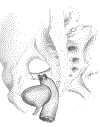Design of a 3-Arm Randomized Trial for Posthysterectomy Vault Prolapse Involving Sacral Colpopexy, Transvaginal Mesh, and Native Tissue Apical Repair: The Apical Suspension Repair for Vault Prolapse in a Three-Arm Randomized Trial
- PMID: 31860566
- PMCID: PMC7326314
- DOI: 10.1097/SPV.0000000000000803
Design of a 3-Arm Randomized Trial for Posthysterectomy Vault Prolapse Involving Sacral Colpopexy, Transvaginal Mesh, and Native Tissue Apical Repair: The Apical Suspension Repair for Vault Prolapse in a Three-Arm Randomized Trial
Abstract
Objective: The objective of this study was to present the design of the Apical Suspension Repair for Vault Prolapse in a Three-Arm Randomized Trial (ASPIRe), which compares the efficacy and safety of 3 apical repairs: native tissue (NT) transvaginal repair, transvaginal mesh, and sacral colpopexy.
Methods: Patient selection criteria, primary and secondary outcome measures including patient-reported outcome questionnaires, masking, surgeon certification, procedure standardization, adverse events collection and adjudication, and cost analysis will be described for this multi-centered randomized trial. Given the unique risks/benefits of each technique, a noninferiority design will be used to compare apical transvaginal mesh to mesh sacral colpopexy. A superiority design will be used to compare the 2 mesh repairs to NT transvaginal apical repair. Survival analysis will be used to assess a composite primary outcome for success composed of a subjective measure (no prolapse symptoms), objective measure (no prolapse beyond the hymen), and no prolapse retreatment, with a minimum follow-up of 36 months. Secondary outcome measures collected every 6 months include assessment of validated general and condition-specific quality of life measures, global impression of improvement, satisfaction and regret, body image, and sexual function.
Results: Randomization and surgical treatment of 360 participants are complete, and the study is in the follow-up phase.
Conclusions: This report will provide valuable insight on the design of a novel 3-arm surgical trial using mesh versus NT to repair vaginal vault prolapse. This trial will provide level 1 evidence on the risks and benefits of mesh augmented versus NT apical repairs.
Trial registration: ClinicalTrials.gov NCT02676973.
Figures




References
-
- Urogynecologic Surgical Mesh Implants | FDA; https://www.fda.gov/medical-devices/implants-and-prosthetics/urogynecolo....
Publication types
MeSH terms
Associated data
Grants and funding
- U10 HD041261/HD/NICHD NIH HHS/United States
- U10 HD054215/HD/NICHD NIH HHS/United States
- U10 HD054214/HD/NICHD NIH HHS/United States
- UG1 HD069006/HD/NICHD NIH HHS/United States
- U01 HD069031/HD/NICHD NIH HHS/United States
- U10 HD041267/HD/NICHD NIH HHS/United States
- UG1 HD054215/HD/NICHD NIH HHS/United States
- U10 HD069025/HD/NICHD NIH HHS/United States
- UG1 HD069010/HD/NICHD NIH HHS/United States
- U10 HD069013/HD/NICHD NIH HHS/United States
- UG1 HD054214/HD/NICHD NIH HHS/United States
- U10 HD069006/HD/NICHD NIH HHS/United States
- U10 HD069010/HD/NICHD NIH HHS/United States
- UG1 HD041261/HD/NICHD NIH HHS/United States
- U24 HD069031/HD/NICHD NIH HHS/United States
- UG1 HD054241/HD/NICHD NIH HHS/United States
LinkOut - more resources
Full Text Sources
Medical
Research Materials

